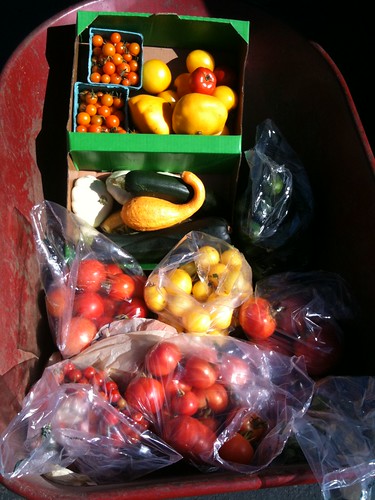But today, I can honestly say that I'm proud of my work. Specifically, I'm proud of an article I recently wrote and published with my graduate student.
This is not the first article I've published, but it may be the first one that I literally want to share with just about everyone! [Right about now, you should be thanking me for not talking about my past work on the mating habits and reproductive fitness of wing-dimorphic planthoppers. Fun study. Not a zippy cocktail party topic.]
I decided to write this article while contracted to work on another project. Growing Healthy Kids is an OSU Extension nutrition education curriculum that uses gardening as a vehicle to teach healthy habits. I was thus somewhat sad to see that a lot of the gardening activities I included in this first version of the curriculum had been edited out of the final product. Actually, I was really, really sad.
One reason that gardening was edited out, was because rules governing USDA SNAP-Ed programs didn't allow gardening to be the focus of nutrition education programs - at least - not to the extent that I had written gardening into the curriculum. Thankfully, the guidelines have changed for 2013, to allow for greater use of gardening in nutrition education programs. And, right on time, we're set to publish version 2.0 of the Growing Healthy Kids curriculum this October - chock full of garden activities!
A second reason that many gardening activities were edited out of Growing Healthy Kids, version 1.0 is OSU's commitment to research-based practices. OSU Extension - like Extension Services at Land Grant Universities around the nation - has a strong commitment to research-based practices. This is the fantastic thing about Extension Services. When you go to your local Extension Service office to ask for advice on gardening - we focus on research-backed methodologies, rather than simply giving you an opinion.
"It worked this way in my garden. You should try it, too!" is not a suitable answer. We instead look for those options that have been tested and supported by rigorous research.
However, when I originally wrote Growing Healthy Kids, the research on whether or not garden-based programs increased fruit or vegetable consumption was mixed. A few studies showed a positive effect of gardens on changes in fruit and vegetable consumption. Many studies showed no effect.
Enter my 'aha' moment. I haven't had many 'aha' moments in my life, and thus want to highlight this one instance in bold type!
I realized that at least part of the reason many researchers have not been able to show a significant, positive impact of gardens (or any nutrition education program, for that matter) on fruit or vegetable consumption is because there is a limit to the servings of fruits or vegetables one person can eat. Researchers are thus left to look for very small changes.
For example, at the beginning of a research study, a student may eat an average of 1 serving of vegetables each day. By the end of the study, if they eat an average of 2 servings of vegetables per day - that's a really big deal! They increase their vegetable consumption by 100%! However, the researcher is left to document that very small shift from 1 to 2. This difference is small in magnitude - but can have huge, positive implications for the child who doubles their vegetable consumption.
This is what's known as a problem with statistical power - a problem we could circumvent if we conducted a review of the literature, and then subjected the studies that we found to a meta-analysis. Meta-analysis is a statistical technique, that allows you to combine data from different studies, so long as those studies test the same hypothesis. Power problem solved.
So, we searched the published, peer-reviewed literature for studies that looked at the impact of nutrition education programs on changes in:
- students' nutrition knowledge,
- students' preference for fruits or vegetables, and
- students' consumption of fruits or vegetables.
- No nutrition education (control groups)
- Nutrition education without gardening (usually, focused on food groups and nutrition labels)
- Nutrition education with gardening
On the other hand, nutrition education with gardening significantly increased both fruit and vegetable consumption - while having no impact on nutrition knowledge. Kids who garden eat more fruits and vegetables, even if they don't know why they should be eating more fruits and vegetables!
 |
| Harvest from Multnomah County Master Gardener Association demonstration garden, at the Learning Gardens Laboratory, 6801 SE 60th Ave., Portland. Photo submitted as part of a Marje Luce Search for Excellence application, 2012. |
So, it may be bold to say - and this was not the focus of our research - but it isn't too great of a leap to suggest that if you teach a kid to garden, you're teaching them to eat healthy! Go gardeners!
this is a phenomenal post, and you should be proud! No produce tastes better than the produce you produce yourself!
ReplyDeleteStephen @ Del Co MG
Hi Gail, So pleased to see this article is published and will be available to read. Thanks for sharing the story behind the research. I know many will look forward to reading it.
ReplyDeleteThis comment has been removed by a blog administrator.
ReplyDeleteLetting them clean carrots, snap beans, mix the dressing and set the table gives them a sense of pride and makes them more enthusiastic and cooperative at meal time.
ReplyDeleteNice blog: Benefits of Eating Fruit and Vegetables
ReplyDelete